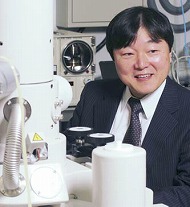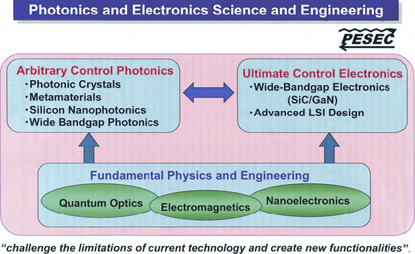Global COE Programs
COE for Education and Research on "Photonics and Electronics Science and Engineering"

Program Leader:
Prof. Susumu NODA
In establishing the COE for photonics and electronics science and engineering to investigate and develop innovative technologies that will achieve an arbitrary manipulation of photons (light) and an ultimate control of electrons, this program exemplifies our motto: "Challenge the limitations of current technology and create new functionalities."
In the 20th century, technologies for information processing (including communication, recording, and sensing) and energy processing (including control, conversion, and lighting) were highly instrumental in enriching human activity.
In the 21st century, existing technologies will be unable to accommodate increasingly rapid changes in the amount of information processed and energy consumed. Therefore, we must develop innovative technologies including structures, operation principles, circuit designs and algorithms-to break through the limitations imposed by conventional concepts of materials and devices.
During the earlier 21st century COE program funded by MEXT (Ministry of Education, Culture, Sports and Technology) from October 2002 to March 2007, the evaluation board highly rated our education and research activities in the field of photonics and electronics. The board ranked our research on photonic crystals, wide band-gap electronics, and LSI designs with the best in the world. By extending and deepening this world-class instruction and research, the proposed program aims to establish the next COE, photonics and electronics science and engineering, in line with our motto: "Challenge the limitations of current technology and create new functionalities." The pertinent ideas underpinning realization of the innovative technologies of this COE can be summarized in the following questions:
- " Can we make a chip to stop (or store) light?"
- " Can we make (nano)lasers based on silicon?"
- " Can we go beyond the diffraction limit of imaging/focusing?"
- " Can we realize all solid-state lighting?"
- " Can we create nm-scale LSIs designs that can tolerate inevitable atomic level fluctuations?"
- " Can we make ultra-low-loss power electronics devices that can reduce energy consumption dramatically?"
- " Can we make electronic devices that can operate even at 500℃?"
These challenges highlight the limitations of current technologies and will lead toward solutions for dealing with rapidly increasing information processing and energy consumption.
Another critical mission of the proposed COE program is the education of the next generation of researchers. The COE plans to train highly competent young researchers destined for both academia and industry in Japan and overseas. Selfreliant, internationally minded young researchers with strong leadership skills will be needed to develop next-generation technologies. Therefore, enhanced education for these young researchers will be a key mission of the proposed COE program.
In April 2007, the Photonics and Electronics Science and Engineering Center (PESEC) was established at Kyoto University to serve as platform of the COE program. This center includes three research groups: the Arbitrary Control Photonics Group, the Ultimate Control Electronics Group, and the Fundamental Physics Group. Close collaboration will position these groups to stimulate each other, heighten research levels, and promote international collaborations.
We have built strong connections with internationally recognized research groups around the world. This program aims not only to strengthen existing collaborative networks, but construct new international networks. The PESEC will provide opportunities for collaborative researchers worldwide to share profound knowledge, high quality research facilities, and new, highly functional materials/devices in photonics and electronics science and engineering. This will facilitate research collaborations and scientist exchanges with partners all over the world. The exchange program for young scientists will particularly contribute to the fostering of future world-class scientists as well as the further development of this research field.


